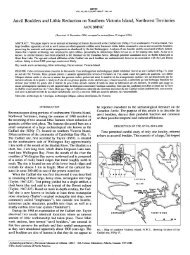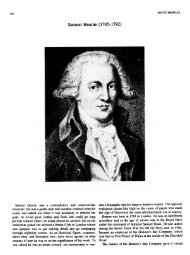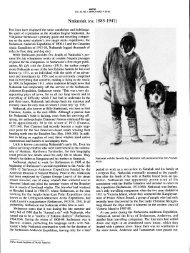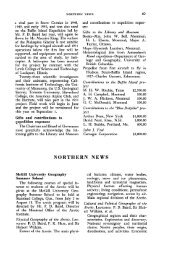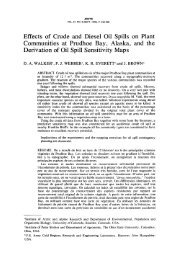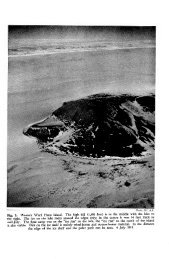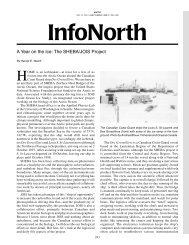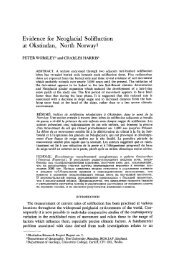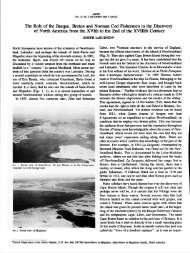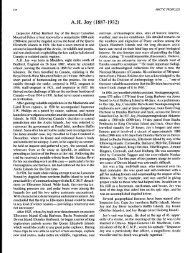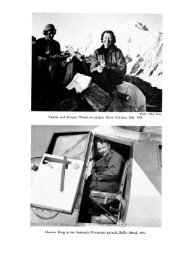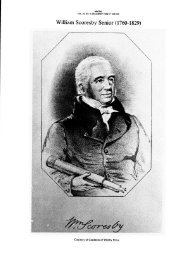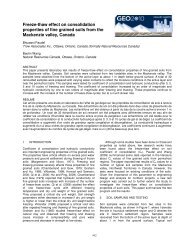NOTES ON THE NUNAMIUT ESKIMO AND MAMMALS OF ... - arctic
NOTES ON THE NUNAMIUT ESKIMO AND MAMMALS OF ... - arctic
NOTES ON THE NUNAMIUT ESKIMO AND MAMMALS OF ... - arctic
Create successful ePaper yourself
Turn your PDF publications into a flip-book with our unique Google optimized e-Paper software.
178 <strong>THE</strong> <strong>NUNAMIUT</strong> <strong>ESKIMO</strong> <strong>AND</strong> MAMhlALS <strong>OF</strong> <strong>THE</strong> ANAKTUVUK PASS REGI<strong>ON</strong><br />
October 1950. It was so badly damaged, however, that it was not retained.<br />
The Nunamiut capture hares by sinew snares during the winter, but since<br />
relatively few are obtained they are of little importance in the diet of the<br />
people.<br />
Lepus othus othus Merriam. Ugalishugruk. Arctic hare.<br />
It is possible that the <strong>arctic</strong> hare may occasionally be found near the<br />
northern limit of the Brooks Range, although little information is available.<br />
The Nunamiut reported having seen this hare near Umiat on the Colville River<br />
and near the mouth of the Anaktuvuk. The Killik people formerly travelled<br />
in this region, but have not done so in recent years. In a letter quoted by<br />
Howell ( 1936 a, p. 334), Charles D. Brower writes: “Several times I have had<br />
these large hare skins brought into Barrow by natives wintering up the Colville<br />
River”. I have made a number of flights by small aircraft over this country<br />
just before snowfall, but sufficiently late in the year for the<br />
and easily visible, but I have yet to see one.<br />
hares to be white<br />
Marmota caligata broweri Hall and Gilmore. Sikrikpuk. Hoary marmot.<br />
Until the present material was obtained, this hoary marmot was known<br />
only from Point Lay and Cape Thompson (Hall and Gilmore, 1934). Scattered<br />
colonies occur commonly in the Brooks Range, and is it often locally abundant.<br />
There is one colony about ten miles south of Tulugak Lake, and others are<br />
found near Anaktuvuk Pass. The Nunamiut say that it is common near the<br />
head of the Killik, also that marmots are found among some sandstone cliffs<br />
from thirty to thirty-five miles north of Tulugak Lake.<br />
Marmots from northern Alaska have been mentioned in the papers of<br />
Bailey and Hendee (1926) and Hall (1929). A4nderson (1934) published a map<br />
of North American hoary marmot distribution, but at that time had no information<br />
on the Brooks Range form. I have so far obtained 8 skins and skulls<br />
of this species from Anaktuvuk Pass, in addition to 7 skins only. The skin<br />
and skull of an adult marmot of this species were obtained near Arctic Village,<br />
on the Chandalar River, and I have examined skins typical of this form from<br />
Big Squaw Lake, farther south near the village of Chandalar. Although considerable<br />
effort was made to obtain marmot specimens in the Romanzof<br />
Mountains, near Lake Schrader and Lake Peters, I was unsuccessful. It is<br />
nevertheless clear that M. caligata broueri is the form found throughout the<br />
Brooks Range, probably as far as the Alaska-Canada boundary.<br />
Brooks Range marmots enter the dens for the winter not later than the<br />
middle of September. The exact time of emergence in the spring is not known,<br />
but as late as 21 May 1950 marmot dens were still snowed in, so it would seem<br />
that emergence must take place in June. By this month much vegetation is<br />
already available for food, particularly saxifrage. Saxifraga bronchialis<br />
Funstonii (Small) Hult. and Pyrola grandiflora Radius are important as food.<br />
Therofon Richardsonii is eaten, as are lupine and various other legumes.<br />
Dens may often be seen from a great distance as the surrounding vegetation,is<br />
more brown and the nearby rocks may be orange from the brightly-



